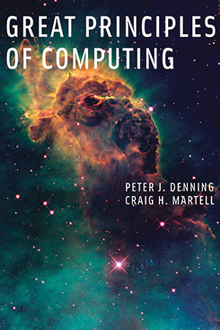More Than Programming
The Association for Computing Machinery’s first curriculum guidelines for universities, published in 1968, featured three major categories of study. The 2013 version lists 18, with many subcategories. “There’s so much computer technology now,” says Peter Denning, PhD ’68, a distinguished professor in the computer science department at the Naval Postgraduate School in Monterey, California. “You could go nuts trying to understand all the technologies.”

By Peter J. Denning, SM ’65, PhD ’68,
and Craig H. Martell
Partly out of concern that the topic has become overwhelming, he’s coauthored a new book, Great Principles of Computing, to simplify it for students. Cowritten with Craig Martell, also a professor at the Naval Postgraduate School, the book organizes computing into six categories—communication, computation, coördination, collection, evaluation, and design—that are akin to “windows of a hexagonal kiosk,” the authors write. “Each window sees the inside space in a distinctive way, but the same thing can be seen in more than one window.”
“We thought the general-principles framework would make it easier to see what was really going on, to see the limits and power of computing and also expose the connections between different technologies,” says Denning, a prolific researcher best known for his pioneering work in virtual memory. “So if you see two technologies based on similar principles, you see the connections better.”
Denning wanted to write Great Principles for another reason as well: to counter the prevailing view that computer science is a “technology field” that deals solely with programming, rather than a true scientific field governed by fundamental principles. “A lot of people, when they look at computer science, say, ‘I see a lot of math there and a lot of engineering there, but I don’t see a lot of science. Where is the science?’” he says.
Well before he began work on the book, Denning had been frustrated by that attitude. When computer scientists were tapped to work on advances in science and engineering, their colleagues in other fields didn’t see them as being able to contribute beyond programming. “This always annoyed me,” he says, “and I spent a lot of effort trying to understand why outsiders didn’t think of computer science as science.”
His new book arrives during a period of renewed interest in coding, especially among kids, fueled in part by online academies. Denning is pleased that computer science is receiving so much attention, but he’s concerned that once again it’s seen as being limited to programming. He says students should investigate the design aspect of computing. Design, he says, is a “noble activity in which the designer looks at concerns and interests in a community of people” and then proposes ways to address those issues.
That need for thoughtful design is one of many facets that make computer science richer than people realize, he says: “There’s more magic and a lot more beauty in it than simply programming.”
Recent Books From the MIT Community
Storm Surge: Hurricane Sandy, Our Changing Climate, and Extreme Weather of the Past and Future
By Adam Sobel, PhD ’98
Harperwave, 2014, $27.99
Screening Room: Family Pictures
By Alan Lightman, professor of comparative media studies/writing
Pantheon, 2015, $25.95
Conflict in Ukraine: The Unwinding of the Post–Cold War Order
By Eugene B. Rumer, PhD ’88, and Rajan Menon
MIT Press, 2015, $24.95
The Measure of American Elections
Edited by Charles Stewart III, professor of political science, and Barry C. Burden
Cambridge University Press, 2014, $99
Yesterdays Revisited: Today’s Youth Views the Holocaust
By George J. Elbaum ’59, SM ’63, PhD ’67
Global Journal of Economics, 2014, $15.95
Making Makers: Kids, Tools, and the Future of Innovation
By AnneMarie Thomas ’01
Makermedia, 2014, $19.99
The Puzzle Files of Larry Logic
By Dan Katz ’03
Sterling Puzzlewright, 2014, $8.95
Architecture by Moonlight: Rebuilding Haiti, Redrafting a Life
By Paul E. Fallon ’77, SM ’81, MArch ’81
University of Missouri Press, 2014, $29.95
Why Information Grows: The Evolution of Order, from Atoms to Economies
By César Hidalgo, assistant professor of media arts and sciences
Basic Books, 2015, $27.99
Please submit titles of books and papers published in 2014 and 2015 to be considered for this column.
Contact MIT News
E-mail: mitnews@technologyreview.com
Write: MIT News, One Main Street,13th Floor, Cambridge, MA 02142
Keep Reading
Most Popular
Large language models can do jaw-dropping things. But nobody knows exactly why.
And that's a problem. Figuring it out is one of the biggest scientific puzzles of our time and a crucial step towards controlling more powerful future models.
How scientists traced a mysterious covid case back to six toilets
When wastewater surveillance turns into a hunt for a single infected individual, the ethics get tricky.
The problem with plug-in hybrids? Their drivers.
Plug-in hybrids are often sold as a transition to EVs, but new data from Europe shows we’re still underestimating the emissions they produce.
Google DeepMind’s new generative model makes Super Mario–like games from scratch
Genie learns how to control games by watching hours and hours of video. It could help train next-gen robots too.
Stay connected
Get the latest updates from
MIT Technology Review
Discover special offers, top stories, upcoming events, and more.